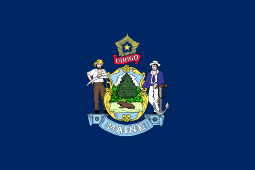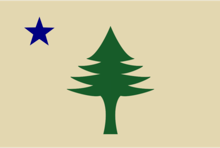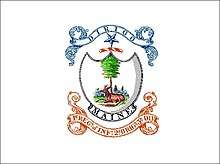Flag of Maine
 | |
| Use | Civil and state flag |
|---|---|
| Adopted | June 16, 1909 |
The flag of the state of Maine features the state coat of arms on a blue field. In the center of the shield, a moose rests under a tall pine tree. A farmer and seaman represent the traditional reliance on agriculture and the sea by the state. The North Star represents the state motto: Dirigo ("I Lead").
The design commonly used omits the circular ring prescribed by Maine Law as a part of the Maine Arms and moves the "Sea and Forest Scene" from the outside of the shield to the inside of the shield. There are no known flags of the State that conform to the official description.
There are no official colors for the coat of arms, so variations in coloration can be seen in flags from different manufacturers. The blue field, however, is specified to be the same blue as in the flag of the United States. According to the official description, the flag should have a fringe of yellow silk and should have a blue and white silk cord attached at the spearhead. These embellishments are very rarely observed.
The law establishing the flag was enacted on February 23rd, 1909, and was modeled after flags used in the Civil War:
§206. State flag. The flag to be known as the official flag of the State shall be of blue, of the same color as the blue field in the flag of the United States, and of the following dimensions and designs; to wit, the length or height of the staff to be 9 feet, including brass spearhead and ferrule; the fly of said flag to be 5 feet 6 inches, and to be 4 feet 4 inches on the staff; in the center of the flag there shall be embroidered in silk on both sides of the flag the coat of arms of the State, in proportionate size; the edges to be trimmed with knotted fringe of yellow silk, 2 1/2 inches wide; a cord, with tassels, to be attached to the staff at the spearhead, to be 8 feet 6 inches long and composed of white and blue silk strands. A flag made in accordance with the description given in this section shall be kept in the office of the Adjutant General as a model.”[1]
Maine is one of 26 US States that use a blue flag with the State Arms or Seal on them.
The North American Vexillological Association conducted a survey in 2001 that ranked Maine's current flag as one of the worst in design. Amongst the 72 U.S. state, U.S. territorial and Canadian provincial flags, Maine's flag ranked 60th (13th worst).[2] NAVA criticized the unoriginality of "[state] seal on blue bed-sheet" design, which is currently used by over half of the flags of U.S. states.
Original flag

Originally, the 1901 Maine Flag consisted of a green pine tree, Native symbol of New England and freedom, in the center, with a blue "North Star", all on a buff-colored background.[3] [4] The image to the right contains a digital reproduction of the 1901 Flag. The reproduction uses a a design similar to the historical usage of the Maine Merchant and Marine flag. In 2018 the Maine Flag Company began producing and marketing original Maine flags using the same pine tree used in the Merchant and Marine Flag of Maine.[5] The size of the tree in the digital reproduction, set to 1/3 the fly and 2/3 the hoist, is guesswork.
The Maine legislature approved the current flag Maine flag on February 23, 1909.
Ensign

Maine is also one of only two states with a separate ensign, which is rarely seen (the other is Massachusetts). It features symbols from the current flag and the older one, with a white field and green pine tree. The green pine tree has the seaman's anchor, and the words "MAINE" and "DIRIGO" around it.
A photograph of the earliest-known specimen of the Maine merchant and marine flag was featured in a June 1939 International News Photos wire photo.[6][7]
First Militia Flags
Maine had a semi official State Color used by its militia from 1822 to 1861. After separating from Massachusetts in 1820, the Maine Adjutant General Samuel Cony needed to supply flags for Maine's approximately 100 militia companies because one of the articles of separation required Maine to return all militia flags (but it failed to mention poles, which were retained and reused). Casting about for a cost effective method of producing such quantity of flags, he engaged John R. Penniman of Boston in 1822 to provide a suitable design which was engraved onto a copper plate and then printed onto silk in multi-colors, the first known production of such for flags. A second printing was done in 1827. About a dozen or so portions of these flags still exist, including one at the Maine Historical Society still mounted on its original pole. The last known instance of a Maine militia unit using this flag was in 1861 at the First Battle of Bull Run, which was recorded as being captured by Confederate forces.

Flag of the 20th Maine

One of several flags used by the 20th Maine Volunteer Infantry Regiment during the American Civil War.
See also
References
- ↑ "Title 1, §206: State flag". Legislature.maine.gov. Retrieved 16 August 2018.
- ↑ "2001 State/Provincial Flag Survey - NAVA.org" (PDF). nava.org.
- ↑ "Maine Flags Prior To 1909 (U.S.)". Flags of the World. Retrieved February 10, 2008.
- ↑ Shattuck, John W. (pseud. of W. J. Sidis). The Tribes and the States (unpublished manuscript), 1935. Chapter XIX, Section 104b. "It was about this time that the old Massachusetts rebel emblem of the Pine Tree, which was in its turn the emblem of the Penacook tribes, denoting the pine forests of New England and the type of freedom native to them, was put into use in modified form as a symbol of protest against arbitrary authority. The Pine Tree was still the emblem of the Massachusetts rebels, especially of the Okamakammesset followers; while those who indulged in the more centralized forms of protest sponsored by the Sons of Liberty in the colonies as a whole used the device in the modified form of a tall pole―the Pine Tree without its needles. These "liberty poles" played a great part in subsequent demonstrations against the authorities in America, and were later adopted as a rebel emblem in other countries." http://www.mortenbrask.com/wp-content/uploads/The-tribes-and-the-states-SIDIS.pdf
- ↑ https://bangordailynews.com/2018/02/13/homestead/maines-once-forgotten-original-state-flag-is-making-a-comeback/
- ↑ https://www.crwflags.com/fotw/flags/us-me-en.html
- ↑ https://www.newspapers.com/clip/23442917/the_daily_clintonian/